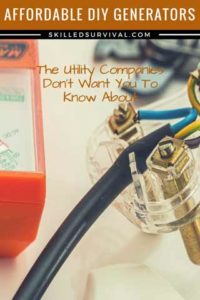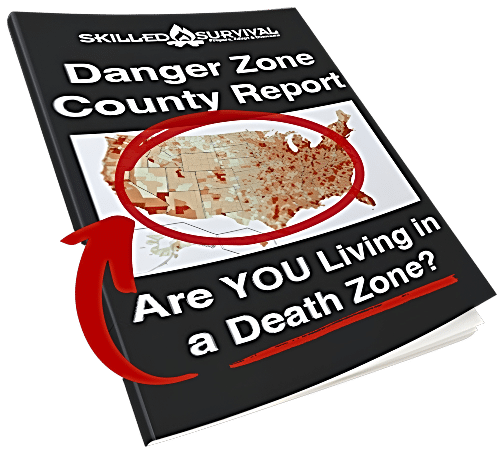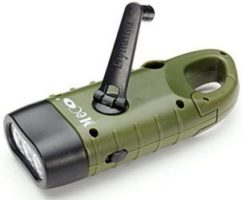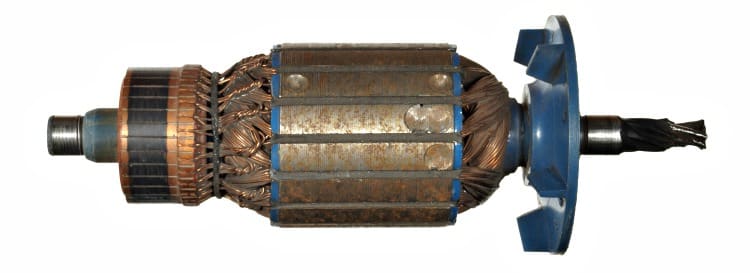
A Complete Guide To Building Your Own DIY Generator
Now, it would be impossible to list ALL the reasons you should build one…
- Maybe you’re preparing for a long-term emergency
- Perhaps you dream of off-grid independence
- Maybe you’d like to knock a few dollars off your electric bill
- Or perhaps you enjoy the art functional science
Regardless of your reason, the goal is the same.
To produce and consume your own electricity…
TOPICS IN THIS GUIDE… ↓(click to jump)
- 8 Best Homemade Generators
- 1. The Bicycle
- 2. Hydroelectric
- 3. Wind Energy
- 4. Hand Crank
- 5. Compost Heat
- 6. Atmospheric
- 7. Solar Power
- 8. Biogas
- Applications For DIY Electricity
- Principals of Making Electricity

Want a free 78 item prepper checklist?
Click here to instantly download this Complete Checklist PDF. No purchase necessary.8 Homemade DIY Generators
There’s more than one way to skin a cat, right?
If you want DIY electricity:
- look to the sky
- look to the sea
- look at the ground
- look in your garage…
The potential for electrical generation is everywhere.
You just need to understand how best to harness it.
1. The Bicycle
This one is first because it’s such a simple generator.
By turning the gears of your bike, you can turn a Rotor.
So you can generate electricity and get a workout at the same time.
Need to boil some water?
No problem, put in twenty minutes on the bike!
Need a reading light?
Pedal while you read!
This requires physical labor.
And you won’t heat a large household using one.
Though you will warm up your body significantly!
So it’s a healthy way to go small, quick power needs.
You don’t even need a whole bike for this setup.
You can build one using old bike parts and a rotor (like an old mower engine).
So there is no need to dismantle your prized bug out bike.
Watch this build to get an idea of it’s possibilities:
↓ Homemade Bicycle Generator
2. Hydroelectric
I think hydroelectricity the BEST option on this list.
Why? Because it’s reliable, consistent, and extremely effective.
Hydroelectric power has been in use for thousands of years.
The ancient Greeks used moving water to grind wheat.
They were not using electricity, but harnessing it’s energy.
Water wheels are the ancient way of achieving hydroelectric energy.
Positioning the wheel in the moving water transfers the motion of the water to the spinning wheel.
This wheel is then attached to the Rotor.
And the energy is collected by Stator before being transferred to a battery.
This produced electricity day and night, non-stop.
Sadly, building and installing a hydroelectric plant yourself is complicated.
Not impossible, but it requires a lot of foresight, preparation, and planning.
And, of course, you need a running body of water nearby.
So they’re location dependent, thus making them rare.
Watch the following series of videos to build your own micro hydro power plant:
↓ Amazing 25+ Watts of Micro Hydro Power Off Grid
↓ Did we make Hydro Power using Our Waterwheel for Self Reliance?
↓ A lifetime of Free Power from Water
3. Wind Energy
The wind is one of your next best option.
A series of large blades capture the wind’s momentum.
And then transfer it to a Rotor/Stator.
Unfortunately, wind turbines present a problem for the average Joe.
They usually require upkeep and maintenance.
That’s why most large-scale wind farms have a team of highly trained engineers.
They’ve been trained specifically to manage these wind turbines.
But it’s becoming easier.
The most important of a wind turbine is investing in an efficient Rotor/Stator.
A turbine that allows you to capture as much of the wind as possible.
However, it work only in windy regions.
You need consistent, reliable wind if you want it to pay off.
↓ DIY Wind Turbine
And here’s a video on how to turn an old cordless drill into a wind turbine:
↓ Build a Cordless Drill Wind Turbine
A side benefit of both wind and water energy is environmental sustainability.

Want a free 78 item prepper checklist?
Click here to instantly download this Complete Checklist PDF. No purchase necessary.4. Hand Crank
I have a flashlight that requires no charging nor batteries.
It’s a hand-crank flashlight.
I crank the handle to create enough friction to power it.
Remember:
Friction is heat, and heat is power.
This is a type of hand crank generator.
It converts human energy into electrical energy.
If you need to conserve calories because food is scarce – a crank generator is a poor choice.
But if you’re lost at sea and need to signal for help, having one is very helpful.
So it’s situational…
Here’s a video on how to turn an old cordless drill into a hand crank generator.
↓ Using a cordless drill as a generator
↓ Super simple Hand crank generator Using Power Tools
5. Compost Heater
How about heat from waste?
Now, heat is not electricity.
But heat is a form of energy and is highly useful.
It’s also exciting to be able to use compost (wood chips, grass clippings, mulch, hay, etc.) to create heat.
You can use heat to warm a small home, a greenhouse, or even a hot tub.
↓ Compost-Powered Water Heater
The one caveat is you need to run a pump to circulate the water.
So while this setup creates heat, it takes some energy input to run.
↓ Agrilab Technologies Compost Heat Recovery
6. Atmospheric Energy
Our atmosphere is full of potential electrical energy waiting to be tapped.
But that’s the challenge, how can you tap this energy for consumption?
It’s possible to capture small amounts of “free” energy.
But nothing I know of has been invented to do so at scale.
However, it’s a source of energy to keep an eye on.
Because, in our modern world, new inventions are always being developed.
↓ Powering with Atmospheric Electricity
↓ Free Collection of Atmospheric Electricity
7. Solar Panels
Everyone knows about solar.
Many homes are either fully or partly powered by solar.
Now the sun’s rays are free.
But collecting them and converting them into usable energy is not.
However, you can cut the costs of installing a solar system if you understand how it works.
And how to build your own DIY Solar Power System.
↓ DIY Solar Setup
If you want to set up a Solar Energy system, check out The Backyard Revolution.
It’s the simplest, easiest-to-use A to Z blueprint…
One ANYONE can follow to make their own cheap electricity…
- Even if you have no money to spend on a ridiculous off-the-shelf $20k system.
- It doesn’t matter if you don’t have the time or patience to go through trials and errors.
- No matter if you’ve never built anything before (not even an IKEA chair)
It’s simple, easy, and cheap – it’s possibly the best solution on the market today!
8. Biogas
The idea behind a biogas generator is simple.
First, you need a source of organic waste such as:
- Agricultural waste
- Manure
- Municipal waste
- Plant material
- Sewage
- Green waste
- Food waste
You then put these organic wastes into a large bin called a digester.
In the digester, you fill it with a ratio of organic material and water.
As organic waste breaks down, it releases heat and gas.
This biogas can be harnessed into power.
Converting this cheap (often free) “waste material” into electricity.
↓ Biogas Generator Build
↓ Electricity with Biogas
If your interested, I recommend getting the Liberty Generator blueprints.
Survival Applications of DIY Electricity
Electricity makes life easier.
The quality of human life worldwide has skyrocketed with it.
But for illustrative purposes, here’s a short list of survival applications of electricity:
Heat
First, electricity generates heat.
Especially during the winter months and in cooler regions.
Having a method to quickly and efficiently warm your shelter is an absolute game-changer.
Cooking
With electricity, you don’t have to go through the trouble of starting a fire to cook.
Nor do you need to keep a large supply of firewood on hand (although I recommend it).
Life is easier using hot plates, electric skillets, toasters, or crock pots.
All of which make meal preparation a breeze
Lighting
Emergency candles and gas lanterns have a nostalgic appeal.
But they’re not the most efficient way to light a room.
Modern LED electric bulbs use little energy and last a long time.
There are also many rechargeable options for solar lanterns, flashlights, and lamps.
Entertainment
Entertainment can be a valuable survival supply.
Why? Because it preserves your sanity -which is invaluable in a survival situation.
Heck, sanity is a valuable resource in any situation.
Charging a cell phone or a small radio can make miserable circumstances bearable.
Of course, a library of survival books and survival playing cards are electricity-free forms of entertainment.

Want a free 78 item prepper checklist?
Click here to instantly download this Complete Checklist PDF. No purchase necessary. The Principals of Making Electricity
The Principals of Making Electricity
Electric generators all share the same principles.
The first one is pretty basic but fundamental:
Any time you use electricity, you getting that energy from somewhere else.
Whether it’s a coal plant, running water, or wind, the power comes from other forms of energy.
You convert one type of energy (wind, water, geothermal) into another (electricity).
So how do you turn energy of moving water into usable power?
Watch this video to learn ‘the basics’ and clear up several misconceptions:
↓ How Electricity Actually Works
All electric motors are made out of two essential pieces:
The Stator and The Rotor.
- The Stator is a stationary shell that houses the Rotor.
- The Rotor is filled with magnets (to create a magnetic field).
This setup generates an electric current as they spin.
That current is captured within the Stator’s built-in coils of wire.
Most stators use copper wire for this.
And these wires transfer the energy to a battery.
Basically, the larger the battery, the more energy you can store.
If you use it often, get a large battery.
One with a significant amount of storage potential.
Or even better, a bank of batteries connected in series.
AC vs. DC Generators
Of course, you must understand the difference between AC vs DC:
↓ How Do AC and DC Generators Work?

Want a free 78 item prepper checklist?
Click here to instantly download this Complete Checklist PDF. No purchase necessary.Final Thoughts
Electricity is one of the most effective survival tools ever harnessed by man.
It makes life on Earth easier.
We leverage it to accomplish an endless number of goals.
And the best part is the energy is everywhere…
Just waiting for you and your DIY generators.
Extract it from the wind, or the water, use your own physical power, or transfer it from another energy source.
If you commit those principles to memory, you can build a generator from scratch almost anywhere.
Now THAT’s self-reliance.
Why Trust Skilled Survival...
Go here now to review a full breakdown of:
- Who We Are
- Our Credentials
- Our Mission
- & Product Recommendations...
Here are a few highlights of our teams credentials & certifications:
- Certified Member of a Mountain Search & Rescue Organization
- Plant Emergency & Safety Leader for a Major Food Manufacturer
- Member of the 10TH Mountain Division Hut Association
- Certifications: Avalanche 1, WFR, CPR
- Official Gear Tester for Numerous Outdoor Gear Companies
- Countless Multiday Backpacking trips into Remote Wilderness
- Bachelor's Degree In Mechanical Engineering
- Bachelor's Degree In Civil Engineering
- Bachelor's Degree In Biomedical Engineering
"It takes 20 years to build a reputation and five minutes to ruin it." - Warren Buffett
We're fully aware that trust is NOT something you GET but is EARNED.
And we'll continue to earn YOUR trust through our forthright and honest approach with each new Blog Post, Guide & Product we create...
Prepare, Adapt & Overcome,

P.s. Do You Live In A 'Danger Zone' County?

Find out now using my Danger Zone County List & Special Report it’s absolutely FREE.
In minutes you’ll know EXACTLY where you stand and if you should be worried or not..
So click here to get my FREE Danger Zone County List & Report…

Recommended Reading
Survival Pack: How To Build One NOW (before SHTF)
Survival pack list From Scratch. Packs That Will Make You A Hero To Your Family. Plus, Some Of Th Best Packs You Can Buy
Best Survival Packing List To Plan For An Evacuation
Everyone needs a survival packing list to organize their escape. That way you won't regret leaving something critical behind.
13 Best Wild Edibles ANYONE Can Find Nearly Everywhere…
Discover the best wild edible plants you can find and eat nearly anywere. Knowing and identifying these wild edibles could save your life.
How To Make Catfish Bait: My Grandpa’s Ultimate Recipe
I want to share with you what I consider the best catfish bait recipe. Here's how to make stink bait that will get the catfish to bite.
Paracord Projects: 17 Survival Devices You Can Make
I share the best paracord projects that are both fun and useful. By doing these crafts you'll always have lifesaving cordage on hand.
Best Survival Skills Every Adventurer Should Learn
The best survival skills will keep you alive even in extreme conditions. 1. Water 2. Shelters 3. Fire 4. Navigation 5. Signaling 6. Medical 7. Foraging...

